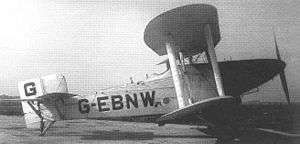Avro 571 Buffalo
The Avro 571 Buffalo was a prototype British carrier-based torpedo bomber biplane, designed and built by Avro in the 1920s. It was not selected for service, the Blackburn Ripon being ordered instead.
| Type 571 Buffalo | |
|---|---|
 | |
| Role | Torpedo Bomber |
| Manufacturer | Avro |
| First flight | 1926 |
| Status | Prototype |
| Number built | 1 |
Design and development
The Avro 571 Buffalo was designed by Avro as a private venture to meet the requirements of Air Ministry Specification 21/23, for a two-seat torpedo bomber and reconnaissance aircraft, intended to replace the Blackburn Dart. The prototype (G-EBNW) first flew at the Avro works at Hamble during 1926.[1] It was evaluated against the Blackburn Ripon and the Handley Page Harrow, but was found to have poor handling and was therefore rejected.[2]
The prototype was therefore rebuilt as the Avro 572 Buffalo II, with new, all-metal wings, fitted with controllable Handley Page slats and a more powerful engine. In this form, the Buffalo was much improved. By this time however, the Ripon had been declared the competition winner.[2]
Operational history
After it failed to be ordered into production, the Buffalo was converted into a seaplane in 1928 for the Air Ministry. As serial number N239, it was used for trials at the Marine Aircraft Experimental Establishment at Felixstowe.
Variants
- Avro 571 Buffalo I
- Prototype powered by 450 hp (340 kW) Napier Lion Va engine.
- Avro 572 Buffalo II
- Rebuilt Buffalo I with new wing and powered by 530 hp (400 kW) Lion XIA.
Specifications (Buffalo II)
Data from Avro Aircraft since 1908. [3]
General characteristics
- Crew: 2
- Length: 37 ft 3 in (11.35 m)
- Wingspan: 46 ft 0 in (14.02 m)
- Height: 14 ft 0 in (4.27 m)
- Wing area: 684 sq ft (63.5 m2)
- Empty weight: 4,233 lb (1,920 kg)
- Gross weight: 7,430 lb (3,370 kg)
- Powerplant: 1 × Napier Lion XIA W-12 water-cooled piston engine, 530 hp (400 kW)
- Propellers: 2-bladed fixed-pitch propeller
Performance
- Maximum speed: 135 mph (217 km/h, 117 kn)
- Cruise speed: 105 mph (169 km/h, 91 kn)
- Range: 650 mi (1,050 km, 560 nmi)
- Service ceiling: 13,700 ft (4,200 m)
- Rate of climb: 770 ft/min (3.9 m/s)
- Wing loading: 10.9 lb/sq ft (53 kg/m2)
- Power/mass: 0.071 hp/lb (0.117 kW/kg)
Armament
- Guns:
- 1 × fixed, forward firing 0.303 in (7.7 mm) Vickers machine gun (not Mk II) and 1 × 0.303 in (7.7 mm) Lewis Gun in rear cockpit
- Bombs:
- 1 × 18 in (457 mm) torpedo
or
- up to 3 × 520 lb (236 kg) bombs
References
| Wikimedia Commons has media related to Avro 571 Buffalo. |
Notes
- Jackson 1990, p.229.
- Mason 1994, p. 157.
- Jackson 1990, pp. 231–232.
Bibliography
- Jackson, A.J. Avro Aircraft since 1908. London: Putnam Aeronautical Books 2nd edition, 1990. ISBN 0-85177-834-8.
- Mason, Francis K. The British Bomber since 1914. London: Putnam Aeronautical Books, 1994. ISBN 0-85177-861-5.